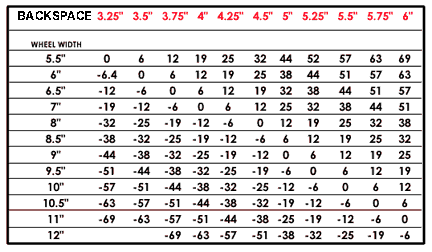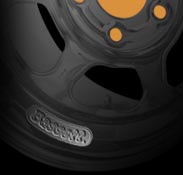| 
Are Bassett Racing Wheels Covered by a Warranty?
Due to the nature of the products offered, there is no warranty representation or condition of any kind, expressed or implied, including no warranty of merchantability or of fitness for intended purpose, or any other obligation on the part of Bassett Racing Wheel. Use these products at your own risk. Bassett Racing Wheel is not responsible for damage to a race car, engine, or other parts, labor, personal injury, or any other damage or injury resulting from use of its products. Bassett Racing Wheel reserves the right to make changes in design, materials and specifications or to make product changes without incurring liability or obligation with respect to similar products previously manufactured.
How long should I use my Bassett Racing Wheels?
Because the fatigue rate of a race wheel varies dramatically from one racer to the next, it is impossible to guarantee your wheel will last any specified length of time. Because right side wheels will fatigue faster than left side wheels, replace right side wheels more often. Bassett Racing Wheel recommends rotating wheels from the right side to the left side every other race. For those using right side specific backspace wheels, rotate wheels front to back every other race. Replace wheels with unusual lug seat wear and/or bent bead flanges.
What is the correct lug nut to use and how tight should I torque the lug nuts?
Bassett Racing Wheels require a hardened steel, 1" oversize, open-ended lug nut with a 45 degree seat chamfer. Before going on the track, always use a torque wrench and torque lug nuts to 85 ft.-lbs. For brand new wheels, make sure to retorque after first use because as the powder coat paint gets worn off, it can cause the lug nuts to loosen slightly.
I want to balance my new Bassett Wheels and tires. How do I ensure an accurate balance?
Bassett Racing Wheels are lug-centric, which means the wheel is constructed and trued off of the bolt circle. Do not use hub rings or attempt to balance Bassett Wheels off the center hub bore! We recommend locating a tire shop that uses a Hunter GSP 9700 Road Force balancer. Hunter's website allows you to search by zip code and find the nearest GSP 9700 balancer.
From the results list, call the tire shop before visiting and ask if they have a flange plate bolt pattern adapter for your vehicle's bolt pattern. If they do not, try the next shop on the list.
Once you find a shop that has the bolt pattern flange plate adapter on hand, insist that the tire mounter balance your lug centric wheels without using the GSP 9700 centering cone - just use the flange plate adapter to center the wheel and tire on the machine.
This will result in a properly balanced Bassett Racing Wheel and tire.
Why do you recommend a steel spacer plate?
FOR RACING APPLICATIONS ONLY! All Bassett 5-bolt and 4-bolt wheels feature a torque ring connecting the stud holes that dramatically strengthens the wheel center. In order to work correctly, the torque ring must make 360 degrees of contact with the mount surface both above and below the stud holes. To ensure full contact with our 5x5", 5x4.75" and 5x4.5" bolt pattern wheels, the minimum diameter of the mount surface must be 7". If less, use a 7" steel spacer plate. For all other bolt patterns, ensure the minimum mount surface diameter is 5" or larger.
What should I use to clean my Bassett Racing Wheels?
Bassett recommends using warm water, car soap and a soft cloth. Do not use brake cleaner, wheel cleaners, degreasers, dish detergent or any harsh chemicals. The silver powder coat is especially sensitive to cleaners and brake dust must be removed promptly after each race to prevent it from embedding in the finish.
I race on dirt. What tire pressure should I run?
Bassett Racing Wheels with a bead hump are designed to keep the tire from rolling off on a dirt track. Contact the tire manufacturer for the recommended range for your type of car and track. For heavy dirt tracks with ruts or a big cushion, we recommend increasing left rear and right front air pressure 2-3 psi to help prevent the tires from rolling off. If you continue to have right front tires rolling off, you may need to increase your negative camber.
I'd like to put Bassett Racing Wheels on my street car. Are all your wheels safe for street use?
We do not recommend using any Bassett Racing Wheel on the street except those specifically stamped DOT. While all Bassett Racing Wheels have been rotary fatigue tested to withstand incredible cornering loads, the Unitied States Department of Transportation regulates on-highway wheel standards. A wheel must have a minimum shell material thickness of .125" and fit a Tire and Rim Association profile gauge in order to be stamped DOT. Bassett Racing Wheels are primarily used for closed course racing and as such are designed to be the lightest possible. Most of our wheel rim shells use material that is less than .125". Our rim shell profiles are designed to build a variety of backspaces and make tire mounting / dismounting easier, so most do not conform to Tire and Rim Association DOT profiles. To view Bassett DOT wheels, click here.
What is the difference between backspace and offset? How do I figure out what my backspace should be?
Wheel offset is the plus or minus measurement (in mm) from the center line of the wheel's width. Backspace is the measurement (in inches) from the mount surface of the wheel to the inside (or back) edge of the wheel, including the bead flange. Please refer to the following chart to convert wheel offset (black numbers) to backspace (red numbers) and vice versa.

If you have additional questions, please send us an email at sales_contact@bassettwheel.com, or call us toll-free at 888-888-7199.
|

